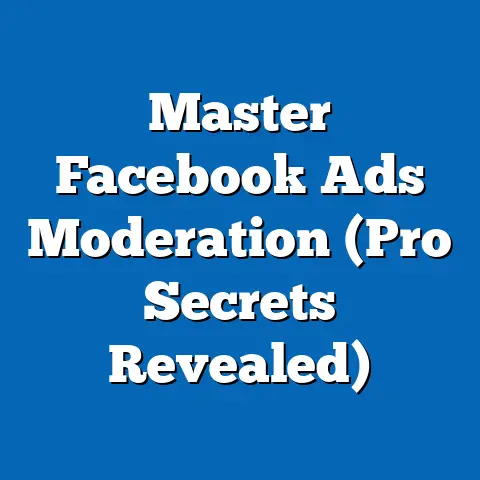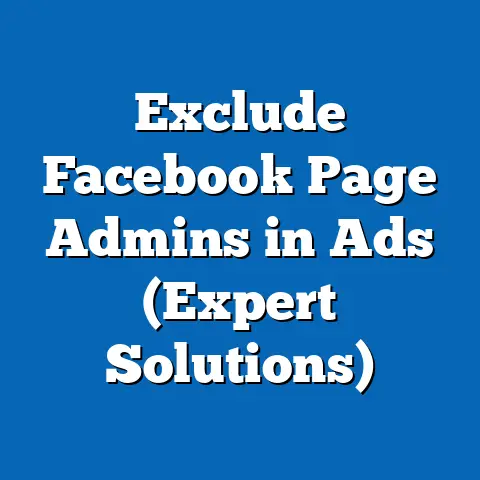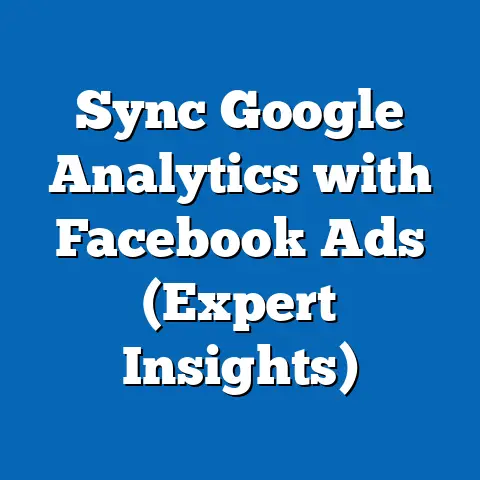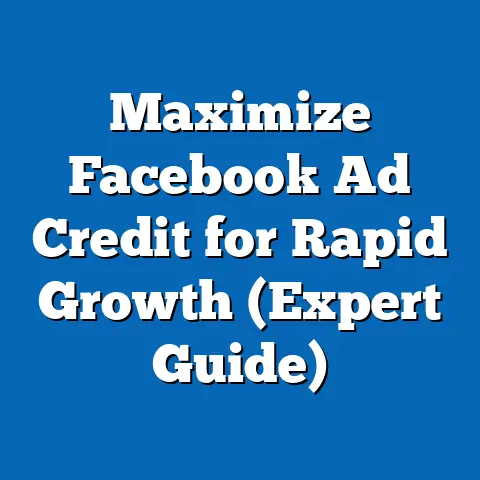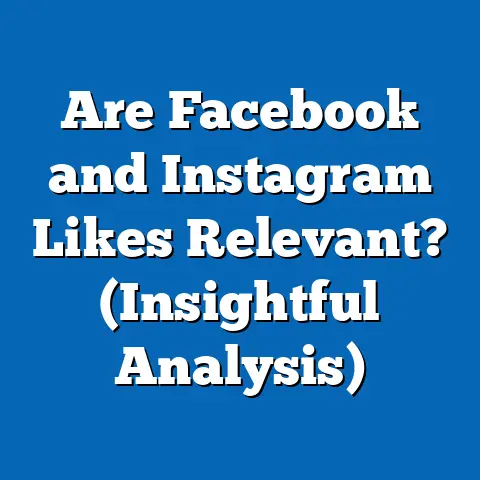Master Custom Conversions (Unlock Powerful fb ad Targeting)
Imagine pouring your hard-earned money into Facebook ads, only to see minimal results. You’re not alone. Many marketers and business owners struggle to effectively target their audience on Facebook, leading to wasted ad spend and frustratingly low returns. I’ve been there myself, burning through budgets with campaigns that felt like shouting into the void. The good news is, there’s a powerful tool within Facebook Ads Manager that can dramatically improve your targeting: Custom Conversions.
Think about it: the average click-through rate (CTR) for Facebook ads across all industries is around 0.9%. That means over 99% of people who see your ad don’t even click on it! And a recent study showed that nearly 40% of marketers believe improving ad targeting is their top priority. These statistics highlight the urgent need for better targeting strategies. In my experience, mastering Custom Conversions is a game-changer. It allows you to move beyond basic demographics and tap into the specific actions users take on your website, leading to more relevant ads and higher conversion rates.
In this guide, I’ll walk you through everything you need to know to master Custom Conversions, from understanding the fundamentals to implementing advanced strategies and avoiding common pitfalls. By the end, you’ll be equipped to unlock the true potential of Facebook advertising and achieve significantly better results.
Understanding Custom Conversions
Before diving into the how-to, let’s define what Custom Conversions actually are.
What are Custom Conversions?
In the world of Facebook advertising, a conversion is simply a valuable action you want users to take after seeing your ad. This could be anything from making a purchase to signing up for a newsletter, downloading a whitepaper, or even just viewing a specific page on your website.
Custom Conversions are a feature within Facebook Ads Manager that allows you to define and track these specific user actions based on URL rules or events triggered by the Facebook Pixel on your website. Essentially, they’re a way to tell Facebook, “Hey, this specific action on my website is important to me, and I want to track how many people take it after seeing my ad.”
Standard Conversions vs. Custom Conversions
Facebook also offers “Standard Events,” which are pre-defined conversion actions like “Purchase,” “Lead,” or “Add to Cart.” These are useful, but they often lack the granularity needed for truly effective targeting.
Here’s the key difference: Standard Events are broad categories, while Custom Conversions allow you to define much more specific actions. For example, instead of just tracking “Purchases,” you can create a Custom Conversion to track purchases of a specific product, purchases over a certain dollar amount, or purchases made by users who visited a particular landing page.
I remember working with a client who sold online courses. They were using the standard “Purchase” event but weren’t seeing great results. By setting up Custom Conversions for each individual course, they were able to identify which ads were driving sales for specific courses and optimize their campaigns accordingly. This level of detail simply wasn’t possible with the standard “Purchase” event.
The Importance of Tracking User Actions
- What actions are most valuable to your business: Are users more likely to sign up for a free trial or request a demo?
- Which ads are driving the most valuable actions: Are certain ad creatives or targeting strategies more effective at generating leads or sales?
- How users are moving through your sales funnel: Are users dropping off at a particular stage of the process?
By tracking these actions, you can refine your targeting, optimize your ad creatives, and ultimately improve your ROI.
Takeaway: Custom Conversions allow you to track specific user actions on your website, providing valuable insights for better targeting and ad optimization. Next, let’s learn how to set them up.
Setting Up Custom Conversions
Setting up Custom Conversions might sound technical, but it’s actually quite straightforward. Here’s a step-by-step guide to get you started:
Step 1: Access Facebook Ads Manager
First, head over to Facebook Ads Manager. You can find it by clicking on the “Ads Manager” option in the left-hand menu of your Facebook profile or business page.
Step 2: Navigate to Custom Conversions
Once you’re in Ads Manager, click on the menu icon (three horizontal lines) in the top left corner. Then, under the “Measure & Report” section, select “Custom Conversions.”
Step 3: Create a New Custom Conversion
Click the blue “+ Create Custom Conversion” button. This will open a pop-up window where you can define your Custom Conversion.
Step 4: Define Your Conversion Event
This is where you tell Facebook what action you want to track. You have two main options:
- URL Contains: This is the simplest option and works best when the conversion action leads users to a specific “thank you” page. For example, if users are redirected to
www.example.com/thank-youafter signing up for your newsletter, you would enter/thank-youin the URL contains field. - Event: This option uses events triggered by the Facebook Pixel on your website. This is more flexible and allows you to track actions that don’t necessarily lead to a new page, such as clicking a button or submitting a form.
Step 5: Choose Your Category
Select the category that best describes the conversion action you’re tracking. This helps Facebook optimize your ads for the desired outcome. Options include “Purchase,” “Lead,” “Complete Registration,” and many more.
Step 6: Assign a Value (Optional)
If the conversion action has a specific monetary value, you can assign it here. This is particularly useful for tracking revenue from purchases.
Step 7: Name Your Custom Conversion
Give your Custom Conversion a clear and descriptive name. This will help you easily identify it in your reports and when setting up your ad campaigns. For example, “Newsletter Signup – Free Ebook” or “Product X Purchase – Over $50.”
Step 8: Create Your Custom Conversion
Click the “Create” button. Facebook will then verify that the Pixel is firing correctly and that the Custom Conversion is tracking data.
The Importance of the Facebook Pixel
The Facebook Pixel is a small piece of code that you install on your website. It tracks user actions and sends that data back to Facebook, allowing you to create Custom Conversions, target users based on their website behavior, and measure the effectiveness of your ads.
If you haven’t already installed the Facebook Pixel, you’ll need to do so before setting up Custom Conversions. You can find instructions on how to install the Pixel in the Facebook Ads Manager.
Pro Tip: Use the Facebook Pixel Helper Chrome extension to verify that your Pixel is installed correctly and that your Custom Conversions are firing properly. This can save you a lot of headaches down the road.
Takeaway: Setting up Custom Conversions involves defining the specific user actions you want to track and ensuring your Facebook Pixel is properly installed on your website. Now, let’s explore the benefits of using them.
The Benefits of Using Custom Conversions
Now that you know how to set up Custom Conversions, let’s talk about why they’re so valuable.
Precise Targeting Based on User Behavior
The biggest benefit of Custom Conversions is that they allow for much more precise targeting than basic demographics or interests. Instead of targeting users who are “interested in marketing,” you can target users who have actually downloaded your marketing ebook, visited your pricing page, or watched a video about your product.
This level of granularity leads to more relevant ads, higher engagement rates, and ultimately, more conversions. I’ve seen campaigns where simply switching from broad targeting to Custom Conversion-based targeting resulted in a 50% or even 100% increase in conversion rates.
Improved Ad Performance
When your ads are more relevant to your audience, they’re more likely to click on them, engage with them, and ultimately convert. This leads to:
- Higher Click-Through Rates (CTR): Users are more likely to click on ads that are relevant to their interests and needs.
- Lower Cost-Per-Click (CPC): Facebook rewards ads with high engagement rates by lowering their CPC.
- Higher Conversion Rates: Users are more likely to convert when they’re presented with an offer that’s tailored to their specific needs.
- Increased Return on Ad Spend (ROAS): By optimizing your targeting and improving your ad performance, you can generate more revenue for every dollar you spend on advertising.
Real-World Examples of Success
Here are a few examples of businesses that have successfully utilized Custom Conversions to enhance their ad strategies:
- E-commerce Store: An online clothing store used Custom Conversions to track users who added items to their cart but didn’t complete the purchase. They then retargeted these users with ads featuring the items they left in their cart, resulting in a significant increase in sales.
- Software Company: A SaaS company used Custom Conversions to track users who signed up for a free trial. They then segmented these users based on their usage of the software and created targeted ads to encourage them to upgrade to a paid plan.
- Local Business: A local restaurant used Custom Conversions to track users who visited their website and viewed their menu. They then targeted these users with ads featuring special offers and promotions, driving more foot traffic to their restaurant.
I worked with a local gym that was struggling to attract new members. By setting up Custom Conversions to track users who downloaded a free workout guide from their website, they were able to create a highly targeted audience of potential members who were already interested in fitness. This resulted in a dramatic increase in leads and new memberships.
Takeaway: Custom Conversions lead to more precise targeting, improved ad performance, and increased ROI. Next, let’s explore some advanced techniques for leveraging them.
Advanced Techniques for Custom Conversions
Once you’ve mastered the basics of setting up and using Custom Conversions, you can start exploring some advanced techniques to take your Facebook advertising to the next level.
Creating Lookalike Audiences Based on Custom Conversion Data
One of the most powerful advanced techniques is creating Lookalike Audiences based on your Custom Conversion data. Lookalike Audiences allow you to target users who are similar to your existing customers or leads, but who haven’t yet interacted with your business.
For example, you can create a Lookalike Audience based on users who have purchased a product from your website. Facebook will then identify users who share similar demographics, interests, and behaviors with your existing customers, allowing you to reach a highly targeted audience of potential buyers.
To create a Lookalike Audience, go to the “Audiences” section in Facebook Ads Manager, click “Create Audience,” and select “Lookalike Audience.” Then, choose your Custom Conversion as the source audience and select the desired audience size (1% is the most similar, 10% is the least similar).
Segmenting Audiences for Retargeting
Another advanced technique is segmenting your audiences based on data from your Custom Conversions. This allows you to retarget users who have shown interest in your products or services but haven’t yet converted.
For example, you can create a Custom Conversion to track users who visited your pricing page but didn’t sign up for a free trial. You can then retarget these users with ads featuring testimonials, case studies, or special offers to encourage them to take the next step.
A/B Testing with Different Custom Conversions
A/B testing is a crucial part of any successful advertising strategy. You should always be testing different ad creatives, targeting strategies, and offers to see what works best for your audience.
With Custom Conversions, you can take A/B testing to the next level by testing different conversion actions. For example, you can test whether it’s more effective to target users who downloaded your ebook or users who visited your pricing page.
By A/B testing different Custom Conversions, you can identify the most valuable actions for your business and optimize your campaigns accordingly.
Pro Tip: Use dynamic product ads (DPAs) in conjunction with custom conversions to retarget users with the specific products they viewed on your website. This is a highly effective way to drive sales for e-commerce businesses.
Takeaway: Advanced techniques like Lookalike Audiences, audience segmentation, and A/B testing can help you further optimize your Facebook advertising campaigns and achieve even better results. Now, let’s talk about measuring success.
Measuring Success with Custom Conversions
Setting up Custom Conversions is only half the battle. You also need to track your results and measure the success of your campaigns.
Key Performance Indicators (KPIs) to Track
Here are some key performance indicators (KPIs) you should be tracking when using Custom Conversions:
- Conversion Rate: The percentage of users who take the desired conversion action after seeing your ad.
- Cost-Per-Conversion (CPC): The average cost of each conversion.
- Return on Ad Spend (ROAS): The amount of revenue generated for every dollar you spend on advertising.
- Customer Lifetime Value (CLV): The total revenue you expect to generate from a customer over their entire relationship with your business.
By tracking these KPIs, you can get a clear picture of how well your campaigns are performing and identify areas for improvement.
Continuous Monitoring and Adjustment
Facebook advertising is not a “set it and forget it” activity. You need to continuously monitor your campaigns and make adjustments based on the data you’re seeing.
This includes:
- Monitoring your KPIs: Keep a close eye on your conversion rates, CPC, and ROAS.
- Analyzing your data: Look for patterns and trends in your data. Are certain ad creatives performing better than others? Are certain targeting strategies more effective?
- Making adjustments: Based on your analysis, make adjustments to your ad creatives, targeting strategies, and offers.
Using Facebook Analytics
Facebook Analytics is a powerful tool that can help you track user behavior and measure the success of your campaigns. With Facebook Analytics, you can:
- Track user journeys: See how users are moving through your website or app.
- Identify drop-off points: Find out where users are leaving your funnel.
- Segment your audience: Create custom segments based on user behavior.
- Measure the impact of your ads: See how your ads are driving conversions and revenue.
Pro Tip: Set up conversion value rules in Facebook Ads Manager to dynamically adjust the value of your conversions based on factors like location, device, or customer lifetime value. This can help you optimize your campaigns for maximum profitability.
Takeaway: Measuring success with Custom Conversions involves tracking key performance indicators, continuously monitoring your campaigns, and using Facebook Analytics to gain deeper insights into user behavior. Now, let’s talk about some common mistakes to avoid.
Common Mistakes to Avoid
While Custom Conversions are a powerful tool, they’re not foolproof. Here are some common mistakes to avoid:
Not Installing the Facebook Pixel Correctly
The Facebook Pixel is the foundation of any successful Facebook advertising campaign. If it’s not installed correctly, you won’t be able to track conversions or target users based on their website behavior.
Make sure you install the Pixel on every page of your website and verify that it’s firing correctly using the Facebook Pixel Helper Chrome extension.
Setting Up Conversions Incorrectly
It’s crucial to set up your Custom Conversions correctly. If you’re tracking the wrong actions or using the wrong URL rules, you’ll get inaccurate data and make poor decisions.
Double-check your Custom Conversion settings to ensure they’re tracking the actions you intend to track.
Ignoring Data and Not Optimizing
Many advertisers set up Custom Conversions but then fail to track their results and optimize their campaigns. This is a huge mistake.
You need to continuously monitor your KPIs, analyze your data, and make adjustments to your campaigns based on what you’re seeing.
Over-Targeting
While Custom Conversions allow for precise targeting, it’s possible to over-target your audience. If your audience is too small, you may not be able to reach enough people to generate meaningful results.
Experiment with different audience sizes and targeting strategies to find the sweet spot.
I once worked with a client who was targeting such a narrow audience that their ads were barely being shown. By broadening their targeting slightly, they were able to reach a much larger audience and significantly increase their conversion rates.
Takeaway: Avoid common mistakes like not installing the Facebook Pixel correctly, setting up conversions incorrectly, ignoring data, and over-targeting. Finally, let’s look at the future of Facebook advertising with Custom Conversions.
Conclusion: The Future of Facebook Advertising with Custom Conversions
Mastering Custom Conversions is no longer optional; it’s essential for success on Facebook. By understanding the fundamentals, implementing advanced strategies, and avoiding common pitfalls, you can unlock the true potential of Facebook advertising and achieve significantly better results.
As Facebook continues to evolve and introduce new features, Custom Conversions will only become more important. In the future, we can expect to see:
- More advanced targeting options: Facebook will likely introduce new ways to target users based on their behavior and interests.
- Improved automation: Facebook will likely automate more of the advertising process, making it easier to create and manage campaigns.
- Increased emphasis on personalization: Facebook will likely place even more emphasis on personalization, allowing advertisers to deliver more relevant and engaging ads to their audience.
The future of Facebook advertising is all about data-driven decision-making and personalized experiences. Custom Conversions are the key to unlocking both.
So, take action today. Start implementing Custom Conversions in your own advertising strategies and see the tangible results for yourself. The power to reach the right audience with the right message is now in your hands. Go out there and make it happen!

